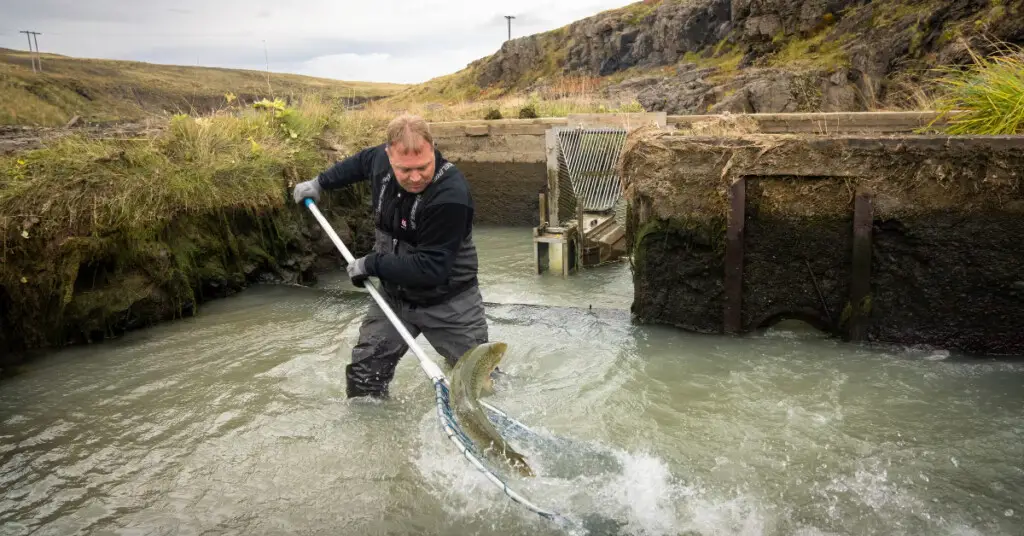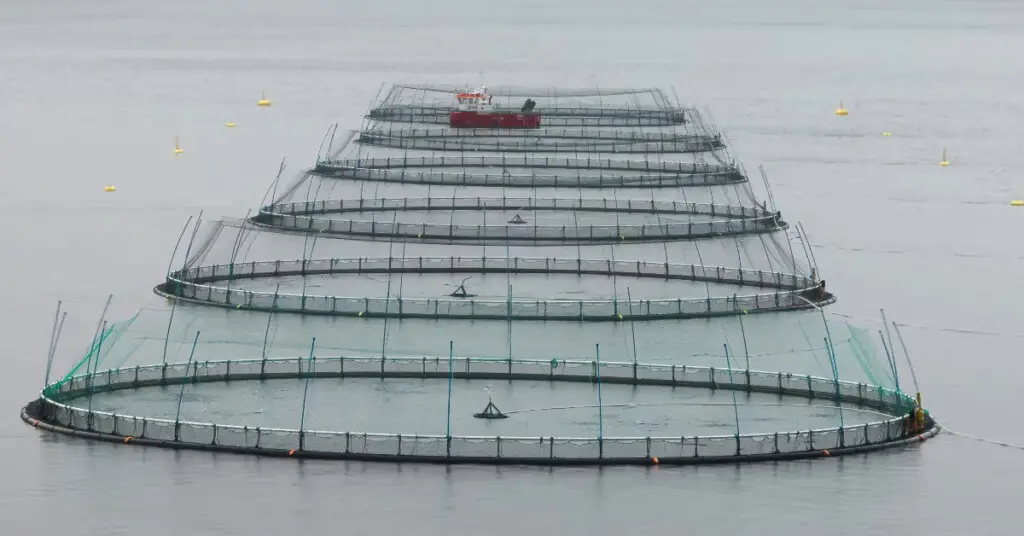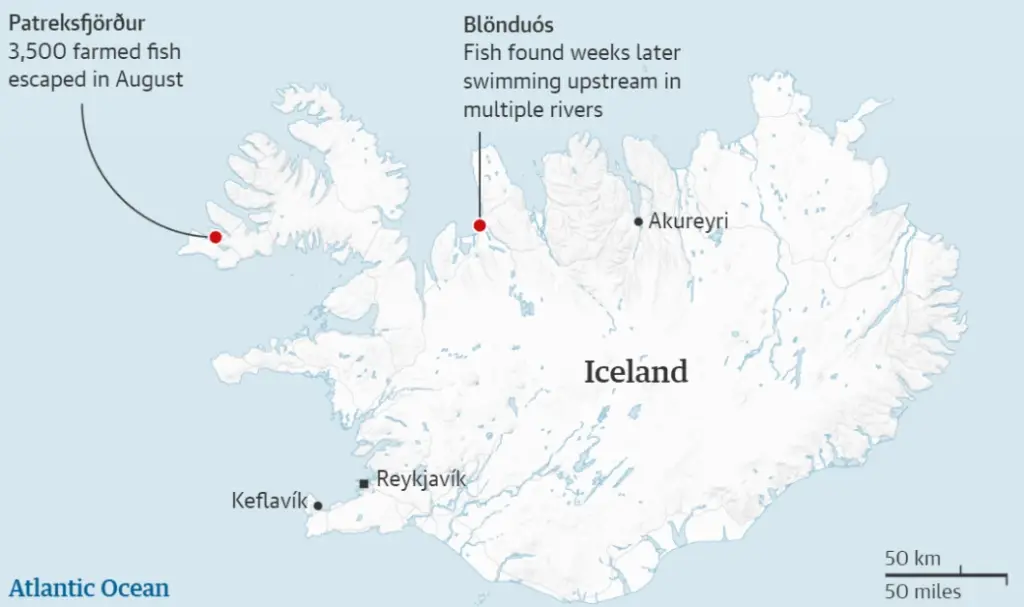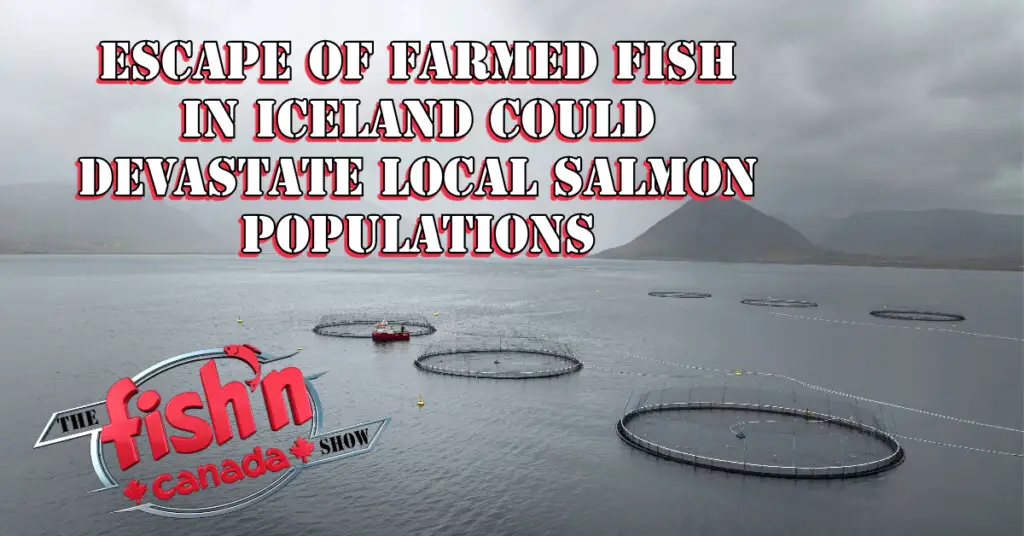Aquaculture has been instrumental in providing employment opportunities and economic growth to rural areas. However, a significant incident in August, where a substantial number of farmed fish escaped, has the potential to severely impact the local salmon populations.
Dressed in black waders, Guðmundur Hauker Jakobsson, commonly known as Gummi, leaps into the River Blanda, whose icy currents originate from the Hofsjökull glacier. Equipped with a net, he carefully scans the ascending pools of the river’s fish “ladder,” designed to assist wild salmon as they journey upstream from the sea.
In a matter of minutes, he retrieves a 15lb silver fish, which vigorously struggles within the net. Then another, followed by three more. The Blanda’s wild salmon, found in the north-west of Iceland, are renowned for their impressive size and athleticism, in a country celebrated for its world-class rivers. This river has attracted the likes of King Charles, David Beckham, Guy Ritchie, and Eric Clapton for salmon fishing.
However, as per Jakobsson, who holds the position of vice-chair in the Blanda and Svartá fishing club, these salmon are “not wild fish.”

Guðmundur Hauker Jakobsson draws a salmon from the river.
Indeed, it displays the distinctive traits of a farmed salmon, with its rounded tail and torn fins. There is a suspicion that it might be one of the escapees from an open-net pen. This pen experienced a significant breach on August 20th, resulting in the escape of thousands of fish that were bred from a Norwegian strain. Subsequently, these escapees have been discovered further upstream in various rivers, posing a serious threat to the native salmon population and making headlines across Iceland.
According to unverified social media posts, it is believed that suspected escapees have been located in at least 32 rivers in north-west Iceland. One post even depicted fish covered in sea lice, a parasite known to be deadly to wild fish. The Marine and Freshwater Research Institute (MRI) of Iceland has confirmed the presence of farmed fish in multiple rivers.
This escape incident, which occurred at a pen in Patreksfjörður owned by Arctic Fish, one of the nation’s largest salmon farming companies and a subsidiary of the Norwegian salmon industry giant Mowi, has reignited the demands of environmentalists, recreational anglers, and certain politicians to impose restrictions or even ban open-net fish farming. It is not the first instance of a significant escape; just last year, another salmon farming company, Arnarlax, was fined £705,000 (approx. 1.2 million CAD) for failing to report the escape of 81,000 fish in 2021.
By shutting down the fish ladder to prevent these farmed salmon from swimming upstream, Gummi, along with his father Jakob, who is 73 years old, has managed to apprehend 44 farmed salmon in the last two weeks. In a garage adjacent to their home in the nearby coastal village of Blönduós, just a short drive from the river, they highlight the distinguishing features that differentiate the farmed fish from their wild counterparts: worn-out gill covers, shortened and deformed snouts, and missing or damaged fins. Gummi has taken the initiative to send 11 of these fish to the MRI for further analysis.
“This is an environmental catastrophe,” he says. “If they breed, the salmon will lose their ability to survive.”
Research has demonstrated that the interbreeding between farmed and wild fish results in offspring that mature at a faster and younger age, ultimately compromising the species’ natural reproductive capabilities.

Farmed salmon with their trademark disfigured snouts.
Scientists emphasize three critical factors that contribute to the severity of this escape: the widespread infiltration of these fish into numerous rivers across a vast area, their unprecedentedly large numbers, and the fact that a significant proportion of them are mature and ready to reproduce.
Just last week, the Icelandic police initiated an investigation to determine whether Arctic Fish violated fish farming regulations. Specialized divers, funded by Arctic Fish, are actively searching for escaped fish. The CEO of the company, Stein Ove Tveiten, along with board members, could potentially face up to two years in prison if found negligent, and he has issued an apology for the incident.
Iceland’s open-net salmon farming sector is relatively young compared to Norway’s, which yielded 1.5 million tonnes in 2021, or Scotland’s 205,000 tonnes. However, Iceland’s industry has experienced remarkable growth, expanding more than tenfold since 2014, increasing from less than 4,000 tonnes to 45,000 tonnes in 2021.

An Arctic Fish farm at Dýrafjörður, Westfjords
The rapid expansion has led to challenges. The national audit office of Iceland discovered that regulations were inconsistent and lacked strength, and the industry was largely without effective oversight. It was observed that the Icelandic Food and Veterinary Authority did not deem additional monitoring necessary, even in the face of significant and recurring violations of regulations.
“This is more than a wake-up call,” says Jón Kaldal of Icelandic Wildlife Fund about the escapes. “All red lights should be blinking. You’re talking about the future of wild salmon.”
On a global scale, the population of wild Atlantic salmon, a keystone species for many mammals and birds, has dwindled from 8-10 million in the 1970s to 3-4 million today. Norway, in particular, has seen a significant decline, with only 500,000 remaining, which is half the number from two decades ago. The primary threats to these wild salmon are escaped farmed fish and the persistent issue of sea lice in open-pen farms. Scotland, over the span of four decades, has experienced a 40% reduction in salmon returning to its rivers. While the Scottish government attributes this crisis to various factors, including the climate emergency, they also acknowledge that sea lice from aquaculture play a partial role in the decline.
Environmentalists also contend that open-pen farms contribute to pollution through the release of organic waste and the use of pesticides to combat sea lice. According to the Norwegian Pollution Control Authority, a medium-sized fish farm, producing around 3,000 tonnes, can generate as much effluent as a city inhabited by 50,000 people. This can lead to eutrophication problems, where excessive nutrients are introduced into water bodies, resulting in harmful algae blooms.
In Iceland, recent findings from July suggest that the extent of hybridization between farmed and wild salmon may be more extensive than previously thought. Importantly, researchers have also discovered evidence that these hybrids not only survive but also produce offspring. Nevertheless, the MRI has raised the allowable catch limit for farmed salmon in Icelandic waters to 105,500 tonnes or 68 million fish, marking a threefold increase.

“We know what will happen if we reach that figure,” says Kaldal. “Wild salmon won’t stand a chance.”
He views the escape incident as a pivotal moment that has the potential to positively impact the ongoing public consultation preceding the anticipated introduction of a new aquaculture bill next year. According to him, one of the most significant challenges lies in the absence of independent monitoring.
“The NAO report confirmed what conservationists have been saying for years,” says Kaldal. “The industry has been given a free ride. They do what they want.”
In Iceland, a country that highly values nature, the majority of people hold a negative stance on open-pen salmon farming. However, in the remote Eastfjords and Westfjords, where the industry is concentrated, it has breathed new life into sparsely populated rural communities, even though it accounts for just about 5.5% of the jobs in the region.
In the small harbor town of Þingeyri, located in the Westfjords, where the towering mountains dwarf the wooden-clad homes clustered around Dýrafjörður, a significant portion of the population has connections to Arctic Fish, the local fish farming company. Many residents tend to dismiss conservationists as individuals from Reykjavík who may not fully comprehend the realities of rural life. The increase in housing prices has been a welcomed development, and the presence of fish farms continues to attract newcomers to the area.

Arctic Fish site manager Bernharður Guðmundsson
During a trip aboard a red and white service boat from the port to one of Arctic Fish’s four sites in the area, Bernharður Guðmundsson, the site manager at Dýrafjörður, asserts that the company adheres to all regulations. He also mentions that his employees have faced insults from conservationists. “Its like we are terrorists or a tobacco company. They want to stop the industry and we lose jobs, but for what purpose?
A single pen, measuring 35 meters in diameter, accommodates between 100,000 and 120,000 fish, which is more than double the population of wild salmon in Iceland. Each site operates with approximately 10 pens. Arctic Fish possesses licenses for 21,800 tonnes of salmon in the Westfjords, with plans for two additional sites.
In response to inquiries about official reports indicating that underwater inspections of some nets in three fjords south of Dýrafjörður were not conducted for three months prior to the escape, Daníel Jakobsson, the head of development at Arctic Fish, refrains from commenting on specific details due to the ongoing police investigation. Nevertheless, he asserts that they are collaborating with authorities to minimize the impact of the incident.
“We have been farming for 10 years and this is the first time an incident of this scale has happened,” he says from his office at Ísafjörður, a town in Westfjords.
Jakobsson does not think that the incident has any consequences for wild salmon. “We have systems in place that ensure wild salmon are not put at risk,” he says. “On top of that, our licences have an expiry date. If we do not behave, we don’t get licences renewed.”
Nonetheless, Svandís Svavarsdóttir, the Minister of Food, Agriculture, and Fisheries in Iceland, asserts that the escape has brought about “significant consequences” for the indigenous salmon population. She emphasizes that the permit holder and the company bear “clear-cut responsibility” to prevent such escapes, and she further mentions the formation of a taskforce to scrutinize the regulations as part of the Aquaculture Act review.





